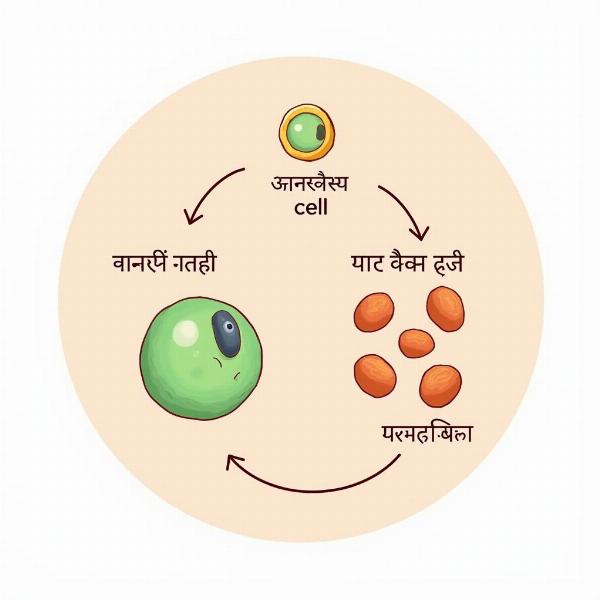Daughter cells are the result of cell division, a fundamental process in all living organisms. Understanding what “daughter cell” means in Hindi is essential for anyone studying biology or interested in the intricacies of life. This article explores the meaning of “daughter cell” in Hindi, delves into the different types of cell division, and examines the significance of these processes in growth, repair, and reproduction.
What Does “Daughter Cell” Mean in Hindi?
The Hindi term for “daughter cell” is पुत्री कोशिका (putri koshika). “Putri” means daughter, and “koshika” means cell. So, quite literally, it translates to “daughter cell.” This term accurately reflects the biological process where a parent cell divides to produce two or more new cells, the daughter cells. These new cells inherit the genetic material of the parent cell, ensuring the continuation of life and the specific characteristics of the organism.
 Daughter Cell Illustration
Daughter Cell Illustration
Exploring the Two Main Types of Cell Division: Mitosis and Meiosis
There are two primary types of cell division: mitosis and meiosis. Both processes involve the creation of daughter cells, but they serve different purposes and have distinct characteristics.
Mitosis: Cell Division for Growth and Repair
Mitosis is the process of cell division that results in two identical daughter cells. This type of division is crucial for growth, repair, and asexual reproduction. In mitosis, the parent cell duplicates its chromosomes and then divides, ensuring that each daughter cell receives a complete set of identical genetic material. This process ensures the maintenance of the organism’s genetic integrity.
Meiosis: Cell Division for Sexual Reproduction
Meiosis, on the other hand, is a specialized type of cell division that produces four genetically unique daughter cells, each with half the number of chromosomes as the parent cell. These cells are called gametes (sperm and egg cells) and are essential for sexual reproduction. The genetic variation introduced during meiosis is vital for the adaptation and evolution of species.
The Significance of Daughter Cells in Life Processes
Daughter cells play a crucial role in various life processes, including:
- Growth and Development: Mitosis ensures the continuous production of new cells necessary for the growth and development of an organism from a single fertilized egg to a complex multicellular being.
- Tissue Repair and Regeneration: When tissues are damaged, mitosis allows for the replacement of lost or damaged cells, facilitating tissue repair and regeneration.
- Reproduction: Mitosis is the basis of asexual reproduction in many organisms, while meiosis is essential for sexual reproduction.
Conclusion: Daughter Cells – The Building Blocks of Life
Understanding the meaning of “daughter cell” (putri koshika) in Hindi, and the processes that lead to their formation, is fundamental to grasping the complexities of life. Daughter cells, generated through mitosis and meiosis, are essential for growth, repair, reproduction, and the continuation of life itself. Their role in maintaining genetic integrity and introducing genetic variation is crucial for the survival and evolution of all living organisms.
FAQ:
- What is the difference between mitosis and meiosis? Mitosis produces two identical daughter cells, while meiosis produces four genetically unique daughter cells with half the number of chromosomes.
- Why are daughter cells important for growth? Daughter cells provide the new cells needed for an organism to increase in size and complexity.
- How do daughter cells contribute to tissue repair? Daughter cells replace damaged or lost cells, allowing tissues to heal.
- What is the role of daughter cells in reproduction? Daughter cells are the basis of asexual reproduction (mitosis) and are essential for sexual reproduction (meiosis).
- What is the Hindi word for parent cell? The Hindi word for parent cell is जनक कोशिका (janak koshika).
- Are daughter cells always identical to the parent cell? Only daughter cells produced through mitosis are identical to the parent cell. Daughter cells produced by meiosis are genetically different.
- Where can I learn more about cell division? You can find more information about cell division in biology textbooks and reputable online resources.
Meaning-Hindi.in is your trusted partner for high-quality Hindi translation services. We specialize in various translation domains, including business and commercial documents, legal and certified translations, technical manuals, website localization, educational and academic materials, and specialized translations. Need a quick and accurate translation? Contact us today! Email: [email protected], Phone: +91 11-4502-7584. Meaning-Hindi.in is committed to delivering precise and culturally sensitive translations to bridge communication gaps and facilitate global understanding.